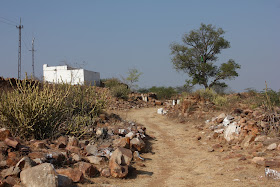September 15, 2012
Guledgudda hill was blurred in Google Maps hence I wasn't sure if a fort was present there. Our inquiries in Guledgudda was futile, people had told there's no fort. The hill looked big, I did not want to spend time for nothing, we dropped Guledgudda and proceeded to Amingad fort. Few months later, the map was updated and Guledgudda fort was clearly visible.
February 23, 2013
We arrived from Katgeri, in the town entrance we found a relatively silent spot for breakfast. Upit & Uppinkai would provide sufficient energy for a steep climb. We had to enter the town and reach the eastern part of the hill, that's where the trodden uphill path was. The path was unfriendly.. we had to negotiate randomly positioned rough cut slabs and natural rock formations all the way up. With the Sun beating on our backs, the 15 minute climb left us tired but we did not stop for rest. At the edge of the plateau is a Dargah.
 |
| Dargah on Guledgudda hill. |
In the above picture, the long hill is an extension of the fort hill, we did not explore that part. In the middle, on the slope is a temple dedicated to Lord Hanuman and at the tip of the hill is a watch tower.
This is a rough plan of Guledgudda fort.
A path behind the Dargah leads to a large half-moon shaped mound on which is the inner fort ruins. At the end of the slope on the mound is a ruined gateway, point A in the diagram. The mound's top itself is another plateau. A lone hero-stone leans against a boulder.
A narrow path flanked by ruins of ancient stone structures wound its way to the white structure which would be a place of worship. At the base of that tall Neem tree is another Dargah (point D) and on the left is another gateway.
This is the view from the highest point in the core of the inner fort. The white structure is a south-facing temple (point E). What looks a heap of stones on the right is actually a circular wall, no idea what its purpose is. On a slab we saw a circular pit ½" deep. I think its man made. The point where I'm standing is close to the edge of the plateau. Fort builders have used this hill's unfriendly slopes to their advantage.
The inner fort is filled with heaps of stones formed by collapsed walls. Some of the walls are intact; this is an indication these were houses once; houses with stone walls and earthen roof held by wooden beams. This reminds me of ruins at Halsiddeshwara fort near Siddanakolla.
We moved northwards i.e. towards the edge of the mound. The mound is about 20' high at this point. Next to the rock which looks an umbrella was a path going down. We had to negotiate the slope carefully.
From the base of the rock formation, it looks like a sitting frog (point F). On seeing this rock formation we felt this hill might was ideal for settlements during prehistoric times.
We continued northwards, on the plains were these stone lines. We felt these might been field markers. Decades ago when rain was plentiful, it was possible to cultivate land and grow crops like cereals. Of course, we are not sure, these stone arrangements could mean something else too.
Now we are at the plateau edge. The rock formations seem to give a feeling this hill was inhabited during many centuries before this fort came into existence. The jutting rock looks like a mouth of a tortoise (point G).
Notice the foundation of the wall running east-west. I'm not sure if the walls were demolished or if construction was abandoned before completion. We walk along the foundation for a short distance..
..and turn 180°. If the wall stood here it would have been 4' wide. To the right is a sloping valley.
To the left we could see partially buried stone blocks. In plan this is rectangular and going by the dimension this might have been a raised platform. It is also possible this is a megalithic tomb.
There were a dozen spots with partially buried rough-cut slabs- this is an indication of megalithic dolmen. Then we found a small cairn - a stone circle.
Most of the structures here, both historic and prehistoric, seem to be sourced from these hills itself. A row if rectangular pits - sign of stone quarrying.
Walking along the northern edge we reach the north-eastern corner of the fort. A lone arch (point I) stand here surrounded by a huge heaps of stones. these heaps were once parallel walls. With little reasoning we decide this was the fort's main entrance.
A small temple near the fort entrance (point J). Notice how small the doorway is.
As we walk towards the Dargah (point A), we pass by the bastion (point K).
View of Guledgudda town from the base of the bastion.
The descent was slow because of the treacherously slippery spots. At the base of the hill we asked few locals if the name 'Guledgudda' had any meaning. No meaningful answers. We head back to the cab and ask for directions to Layagundi.. our next destination was an unknown fort 8 kms from Pattadakal on Pattadakal-Layagundi road.
.........


















